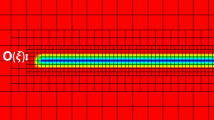Abstract
The dynamic propagation of a crack in an anti-plane shear deformation field is analyzed by second-order-accurate finite differences. The finite difference equations are obtained by integrating the dynamic linear elastic equations of motion along the bicharacteristic strips in four perpendicular directions and the time axis to 0(Δt 3). The singularity in stresses around the crack is calculated by performing a global energy balance on small region containing the crack tip and approximating the stresses and velocity in this region by a one term asymptotic expansion about the crack tip. Results for stresses and stress intensity factor are presented for a semi-infinite crack propagating steadily in an infinite strip, from which errors in the numerical calculations are identified. Four cases of typical non-steady crack propagation in an infinite strip following steady propagation are also considered.
Résumé
La propagation dynamique d'une fissure dans un champ de déformation de cisaillement anti-planaire est analysée en utilisant une méthode de différence finie exacte au second ordre. Les équations de différence finie sont obtenues en intégrant les équations de mouvement dynamique linéaire et élastique le long de 4 bandes caractéristiques distribuées dans 4 directions perpendiculaires et en fonction d'un axe de temps. La singularité des contraintes autour de la fissure est calculée en procédant à un équilibre global d'énergie dans les petites régions qui contiennent l'extrémité de la fissure, et en évaluant les contraintes et la vitesse dans cette région à l'aide d'une expansion asymptotique à un terme dans la zône de l'extrémité de la fissure. Les résultats obtenus pour les contraintes et le facteur d'intensité de contrainte sont présentés dans le cas d'une fissure semi-infinie qui se propage de manière stable dans une bande infinie, un cas pour lequel les erreurs des calculs numériques sont identifiées. Quatre cas de propagation typique de fissure non stable dans une bande infinie suivie d'une fissure stable sont également pris en considération.
Similar content being viewed by others
References
M. Shmuely and D. Peretz,International Journal of Solids and Structures, 12 (1976) 67–79
J. Aboudi,Computer Methods in Applied Mechanics and Engineering, 9 (1976) 301–316
D.J. Andrews,Journal of Geophysical Research, 81 (1976) 3575–3582
G.T. Hahn et al., “Critical Experiments, Measurements and Analyses to Establish a Crack Arrest Methodology for Nuclear Pressure Steels,” U.S. Nuclear Regulatory Commission Progress Report BMI-NUREG-1959 prepared by Batelle Columbus Laboratories, Columbus, Ohio, October 1976
M. Shmuely, in Fast Fracture and Crack Arrest, ASTM STP 627, G.T. Hahn and M.F. Kanninen, Eds., American Society for Testing Materials (1977) 135–141
J.F. Malluck and W.W. King, “Fast Fracture Simulated by a Finite-Element Analysis Which Accounts for Crack Tip Energy Dissipation,” International Conference on Numerical Methods in Fracture Mechanics, Swansea, U.K., January 1978
G. Rydholm, B. Fredriksson and F. Nilsson, “Numerical Investigation of Rapid Crack Propagation,” International Conference on Numerical Methods in Fracture Mechanics, Swansea, U.K., January 1978
Z.P. Bazant, J.L. GlazikJr. and J.D. Achenbach,Journal of Engineering Mechanics Division, ASCE, 102, No. EM3 (1976) 479–495
W.W. King, J.F. Malluck, J.A. Aberson and J.M. Anderson,Mechanics Research Communications, 3 (1976) 197–202
J.R. Rice, “Radiant Energy Dissipation in Crack Propagation,” July 1977Proceedings, ARPA Materials Research Council, University of Michigan, July 1977, Dept. of Matls. Engrg., Technical Report, 1978
R.J. Clifton,Quarterly of Applied Mathematics, 25 (1967) 97–116
P.R. Garabedian,Partial Differential Equations, John Wiley & Sons, Inc. (1964)
G.F.D. Duff,Canadian Journal of Mathematics, 10 (1958) 127–160
D.S. Butler,Proceedings of the Royal Society of London(A), 255 (1960) 232–255
L.B. Freund, inMechanics Today, Vol. 3, ed. S. Nemat-Nasser, Pergamon Press
L.B. Freund and R.J. Clifton,Journal of Elasticity, 4 (1974) 293–299
F. Nilsson,Journal of Elasticity, 4 (1974) 73–75
J.D. Achenbach and Z.P. Bazant,Journal of Applied Mechanics, 42 (1975) 183–189
F.A. Field and B.R. Baker,Journal of Applied Mechanics, 29 (1962) 436–437
G.C. Sih and E.P. Chen,Journal of the Franklin Institute, 290 (1970) 25–35
F. Nilsson,International Journal of Solids and Structures, 13 (1977) 543–548
F. Nilsson, in Fast Fracture and Crack Arrest, ASTM STP 627, G.T. Hahn and M.F. Kanninen, Eds. American Society for Testing and Materials (1977) 77–91
P. Burgers, “An Analysis of Dynamic Linear Elastic Crack Propagation in Anti-Plane Shear by Finite Differences,” Brown University Report, MRL E-107, May 1978
Author information
Authors and Affiliations
Rights and permissions
About this article
Cite this article
Burgers, P. Dynamic linear elastic crack propagation in anti-plane shear by finite differences. Int J Fract 16, 261–274 (1980). https://doi.org/10.1007/BF00013382
Received:
Revised:
Issue Date:
DOI: https://doi.org/10.1007/BF00013382




